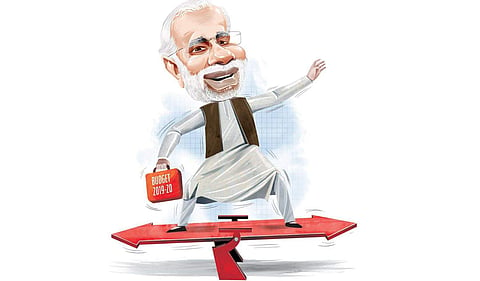

NEW DELHI: The Narendra Modi-led NDA 2.0 government will have to face up to a major challenge in balancing the contradiction between increased spending to reverse a growth slowdown and earning enough revenues to fund the higher expenditure in the budget it places in Parliament next week. The Centre calculates that some Rs 1 lakh crore of infrastructure spending over the next five years is required to meet India’s infrastructure gaps, and rescue its growth story, which has dipped to an anaemic 17-quarter low of 5.8 per cent in January-March 2019.
With reduced consumer spending, slower pace of private investment and government expenditure, GDP growth last year has dipped to a five-year low of 6.8 per cent. On top of that, unemployment hit a 45-year high of 6.1 per cent in 2017-18. Passenger vehicle sales fell for a seventh straight month in May, with car sales contracting by 26 per cent. An uneven monsoon has added to doubts over an early economic recovery.
“Consumers always reduce purchase decisions in a slowing economy. That’s what we are seeing. The way out is usually higher government spending. But the problem with that would be mobilising resources needed for such spending,” said Prof Biswajit Dhar of JNU.
Traditionally, economists espouse the Keynesian prescription of increased public spending on infrastructure to create demand for goods and services, which the industry rushes to provide. This circle of spending and production creates fresh jobs, which results in another cycle of consumer spending, feeding industrial demand.
Besides spending on infrastructure to rekindle India growth story’s ‘animal spirit’, the government will also have to budget for greater expenditure on a number of counts.
It has already announced an extension of PM-Kisan direct income scheme to all farmers, raising the cost to Rs 87,218 crore. The pension schemes for farmers and traders would increase its bill by Rs 12,000-15,000 crore. A plan to complete some 68 pending irrigation schemes is also expected to add to the planned expenditure. Meanwhile, its subsidy bill pegged at Rs 2.96 lakh crore is expected to overshoot.
However, the government’s problem will be with finding funds for the spending spree. Over the past few years, actual tax collections have slowed. Total tax revenue growth slowed to 11 per cent and 8 per cent respectively in the last two years. This trend, analysts believe, will make it difficult for the government to stick to its projection of a near 15 per cent increase in tax revenues in 2019-20.
An ambitious Rs 90,000 crore target from disinvestment in a year when the stock market has been on a roller-coaster ride, and state-run enterprises are already reeling in debt and are in no position to buy each other’s stocks to meet the government’s revenue targets, could make things even more difficult. According to Shilan Shah of Capital Economics, “With no feasible plans in place to increase revenues, spending will have to be pared back.”
Escape formulae
One of the only ways to fund an expenditure increase would be to breach the 3.4 per cent fiscal deficit target by increasing the government’s borrowing. However, this, in turn, would leave less money in the market for private enterprise to borrow from banks to expand or start new enterprises.
Another more controversial way could be to transfer RBI’s ‘surplus capital’ after re-evaluating its capital needs by the Bimal Jalan committee. However, this injection of fresh money into the market could create its own problems – an increase in consumer inflation, something which the government has till now managed to keep a lid on.